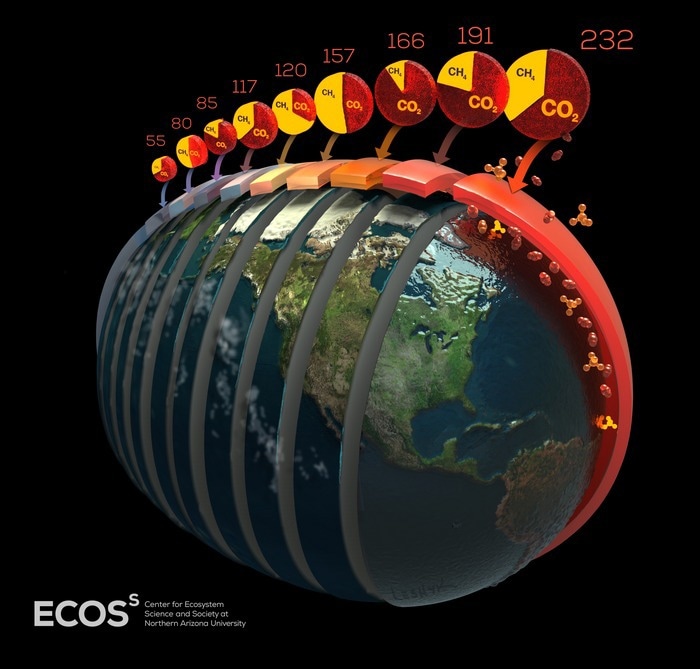Permafrost in the rapidly melting Arctic will probably release as much carbon dioxide and methane into the atmosphere as a large industrial nation by the end of this century, preferably more than the United States has emitted since the beginning of the industrial revolution.

Nine future worlds and their cumulative Arctic carbon emissions by 2100. Linked to low, medium, and high climate warming, the pie above each 'slice' of Earth represents total estimated carbon emissions (from carbon dioxide and methane) this century from the unregulated ‘country of permafrost.’ Image Credit: Victor O. Leshyk, Center for Ecosystem Science and Society.
However, this is simply one conceivable future for the massive amounts of carbon stored in the Arctic’s formerly perpetually frozen but now-thawing ground. Recent research headed by Northern Arizona University and the international Permafrost Carbon Network and published in the Annual Review of Environment and Resources projects cumulative emissions from this “country of permafrost” until 2100 under low, medium, and high warming scenarios.
We hope that these forecasts of future Arctic carbon emissions not only update the scientific picture but act as new guide rails for policymakers who are working to stabilize the climate and avoid exceeding temperature targets.
Ted Schuur, Study Lead Author and Regents’ Professor, Department of Biology and Center for Ecosystem Science and Society, Northern Arizona University
The group calculates that in a low warming scenario—one that could be realized if the global community restricted warming to 2 °C or below by decreasing fossil fuel emissions—permafrost would release 55 petagrams (Pg) of carbon by the end of the century in the form of greenhouse gases carbon dioxide (CO2) and methane (CH4). The results indicated that if nothing is done to curb climate change, the Arctic might emit 232 Pg of carbon by the end of the century.
The team’s predictions go beyond prior worldwide forecasts by accounting for permafrost-specific hydrological and biogeochemical dynamics and tipping points.
For example, researchers observe abrupt thawing in many permafrost regions, where the fast melting of ground ice forces the land surface to collapse, generating lakes or other changes in surface hydrology.
When previously frozen ground erodes or subsides, the carbon stored there can be released into the atmosphere through microbial respiration or methane. Such fast, non-linear changes irreversibly alter permafrost’s capacity to store carbon and have the potential to flip significant areas of the Arctic region from carbon sinks to carbon sources. According to recent estimates, one-fifth of current permafrost terrain is vulnerable to sudden thawing.
Once permafrost carbon emissions increase in response to climate warming as some models predict, there won't be a way for us to stop that process. We may need to reduce our fossil fuel emissions much sooner than currently planned by many governments to avoid triggering possible tipping points in Earth’s climate.
Roisin Commane, Study Co-Author and Assistant Professor, Earth and Environmental Sciences, Columbia University
The story of Arctic carbon and its future security is only partially written because there are still chances that regional and systemic tipping points could be crossed. The new study depicts nine distinct futures dependent on how climate change evolves and what actions global leaders take to cut fossil fuel emissions.
Permafrost emissions will be a large and substantial contributing factor to atmospheric greenhouse gases, no matter which of the possible scenarios becomes reality. But there will be huge differences between mitigation scenarios that matter to the overall global carbon budget.
Guido Grosse, Study Co-Author and Head, Permafrost Research Section, Alfred Wegener Institute in Potsdam
Limiting human-caused emissions, according to Grosse, will ensure permafrost contributes less to global climate warming, whereas “doing business as usual” will ensure that the “nation” of permafrost plays a significant part in warming and represents a larger challenge for mitigation attempts to overcome.
Since the Arctic is not controlled by any single state and its remoteness makes extensive monitoring difficult, the authors underline that future international emission reduction efforts must include this “country of permafrost” in climate targets and activities.
The study also emphasizes the need to monitor this rapidly changing region through collaborative networks such as the Permafrost Carbon Network and scientific tools including remote sensing technologies.
Commane explains, “Remote sensing products can really help us see and track what is happening to permafrost in a physical way. High resolution sensors can see evidence of thermokarst soil collapse, how water bodies are changing, and even how wet or frozen the soils are. But satellites that tell us how much carbon from permafrost ends up in the atmosphere are limited, and there needs to be investment from space agencies in these capabilities as soon as possible.”
Schuur stated that his study team is also witnessing evidence of rapid change on the ground.
Schuur details, “Changes we are witnessing in the field show the urgent need to curb emissions and keep permafrost carbon in the ground. This summer, at my study site in Eight Mile Lake, Alaska, we saw widespread permafrost thaw after a winter with record snowfall, and carbon losses four times larger than the average over the past several decades.”
“These observations match predicted tipping points in permafrost and carbon that we expect to see as human-caused emissions from elsewhere on Earth rapidly warm the Arctic,” Schuur concluded.
The National Science Foundation funded the Permafrost Carbon Network synthesis study.
Journal Reference:
Schuur, E. A. G., et al. (2022) Permafrost and Climate Change: Carbon Cycle Feedbacks From the Warming Arctic. Annual Review of Environment and Resources. doi.org/10.1146/annurev-environ-012220-011847.